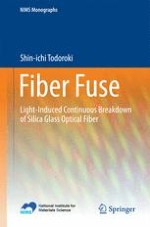2014 | Buch
Über dieses Buch
This book describes the fiber fuse phenomenon that causes a serious problem for the present optical communication systems. High-power light often brings about catastrophic damage to optical devices. Silica glass optical fibers with ultralow transmission loss are not the exception. A fiber fuse appears in a heated region of the fiber cable delivering a few watts of light and runs toward the light source destroying its core region. Understanding this phenomenon is a necessary first step in the development of future optical communication systems. This book provides supplementary videos and photographs to help understand what occurs in the fiber, including the classification of its propagation mode and self-pumping effect. These findings are good references for other optical devices exposed to ultrahigh-power light such as laser emitters.
Anzeige
